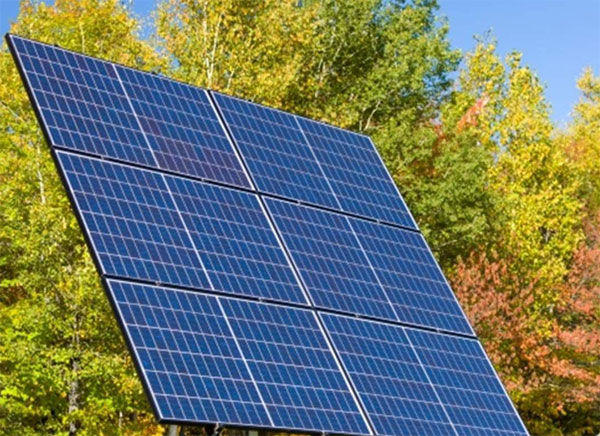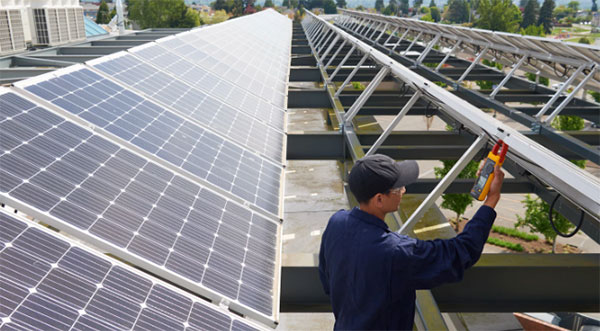Description
Solar panels are most efficient during midday and early afternoon when sunlight is strongest and most direct.

Daily Solar Energy Patterns
Sunrise and Early Morning Performance
As the sun rises, solar panels begin to receive sunlight, initiating the process of energy conversion. During early morning, the angle of sunlight is lower, resulting in a gradual increase in solar panel efficiency. The intensity of solar radiation is relatively mild, which minimally heats the panels. This is crucial because solar panels tend to operate more efficiently at cooler temperatures. However, the lower angle of the sun's rays means that the energy captured is less compared to later in the day.
Key factors influencing early morning performance include the geographic location of the panels and the presence of any environmental obstructions like buildings or trees. For instance, in areas closer to the equator, solar panels start generating significant power earlier due to the higher and more direct sun exposure.
Peak Efficiency: Midday and Early Afternoon
The midday and early afternoon hours mark the peak efficiency period for solar panels. During this time, the sun is at its highest point in the sky, providing direct and intense sunlight. This results in maximum solar radiation absorption by the panels. Technological advancements in solar panel design have optimized them to capture the highest possible energy during these peak hours.
The efficiency of solar panels during these hours can be significantly higher. For example, a standard photovoltaic (PV) solar panel, which typically operates at around 15-20% efficiency, can reach its peak performance during these hours. The specific efficiency depends on factors such as the type of solar panel (monocrystalline, polycrystalline, thin-film), its age, and the quality of installation.
Declining Efficiency: Late Afternoon to Sunset
As the day progresses towards late afternoon and evening, the efficiency of solar panels begins to decline. The sun's angle decreases, reducing the intensity of solar radiation hitting the panels. Additionally, the accumulated heat within the solar panels from the day's peak hours can negatively affect their performance, as solar cells lose efficiency when they get too hot.
Despite this decline, modern solar panels still capture a significant amount of energy during these hours, contributing to the overall daily energy yield. The efficiency drop in the late afternoon varies depending on the type of solar panel and its thermal regulation properties. For example, newer models with better heat dissipation features may show a less pronounced efficiency decline.
Understanding these daily patterns helps in optimizing the use of solar energy systems and can guide the design and placement of solar panels for maximum efficiency throughout the day. For instance, tilting the panels at an angle that captures the most sunlight during midday can significantly increase the overall energy production. Additionally, incorporating tracking systems that follow the sun's movement can further enhance the efficiency of solar panels throughout the day.

Seasonal Variations in Solar Energy
Summer vs. Winter Efficiency
Solar panels exhibit varying levels of efficiency across different seasons, primarily influenced by the changes in sunlight intensity and duration.
Summer:
- Intensity of Sunlight: The sun's rays are more direct and intense, leading to higher energy production.
- Longer Daylight Hours: Longer days result in extended periods of solar energy harvesting.
- Temperature Impact: Despite the increased sunlight, extremely high temperatures can slightly reduce the efficiency of solar panels. For example, if a solar panel's temperature rises above 25°C (77°F), its efficiency can decrease by about 0.5% for every additional degree in temperature.
Winter:
- Reduced Sunlight Intensity: The sun is lower in the sky, causing solar panels to receive less direct sunlight.
- Shorter Daylight Hours: Shorter days translate to fewer hours of sunlight available for energy conversion.
- Temperature Effect: Colder temperatures can increase the efficiency of solar panels. However, this benefit is often offset by the reduced intensity and duration of sunlight.
Impact of Day Length on Solar Energy Harvesting
The length of the day significantly impacts the amount of solar energy that can be harvested.
- Longer Days in Summer:
- Lead to increased energy production.
- In regions near the equator, solar panels can experience up to 13-14 hours of daylight.
- This extended exposure can result in a substantial increase in daily energy output, with solar systems generating up to 30-40% more energy than during shorter days.
- Shorter Days in Winter:
- Result in lower energy yields.
- In some northern or southern regions, daylight hours can be as short as 5-6 hours during the winter solstice.
- This reduced exposure can lead to a decrease in daily energy output by up to 50% compared to summer months.

Technological Advances in Solar Panels
Innovations for Maximizing Efficiency
The solar panel industry has seen significant technological advancements aimed at maximizing efficiency. These innovations not only enhance energy output but also reduce costs and extend the lifespan of solar panels.
- High-Efficiency Solar Cells:
- New materials like perovskite and advancements in silicon cell technology have led to higher efficiency rates. For instance, some modern solar panels have surpassed 22% efficiency, a significant improvement from the average 15-17% in older models.
- Bifacial solar panels, which capture sunlight from both sides, can increase energy production by up to 30%.
- Improved Durability and Lifespan:
- Enhanced materials and construction methods have extended the lifespan of solar panels, with many now offering warranties of 25 years or more.
- Innovations in protective coatings and frame design protect panels from environmental damages, ensuring consistent performance.
- Smart Solar Panels:
- Integration of IoT (Internet of Things) technologies allows for real-time monitoring and optimization of solar panel performance.
- Smart panels can adjust their position automatically to capture maximum sunlight, increasing daily energy output.
- Cost Reduction:
- Advances in manufacturing and economies of scale have led to a significant decrease in the cost of solar panels, making solar energy more accessible.
- The cost of solar panels has dropped by over 70% in the past decade, making solar installations increasingly affordable for both residential and commercial users.
Adaptations for Different Times of the Day
Solar panel technology has also adapted to varying sunlight conditions throughout the day to maximize energy capture and efficiency.
- Solar Tracking Systems:
- These systems adjust the angle of the solar panels throughout the day to follow the sun’s path, significantly increasing energy capture, especially during early morning and late afternoon.
- Single-axis trackers can boost energy production by up to 25%, while dual-axis trackers can offer an increase of up to 40%.
- Energy Storage Solutions:
- Battery storage systems store excess energy produced during peak sunlight hours for use during lower production times, ensuring a consistent energy supply.
- Innovations in battery technology, like lithium-ion and flow batteries, have improved energy storage efficiency and reduced costs.
- Hybrid Solar Panels:
- Hybrid panels combine photovoltaic cells with solar thermal collectors, allowing them to generate electricity and heat water simultaneously.
- These panels are particularly effective in regions with variable sunlight, maximizing the utility of solar energy throughout the day.

Measuring and Monitoring Solar Panel Efficiency
Tools for Tracking Daily Energy Output
Monitoring and measuring the efficiency of solar panels is crucial for optimizing their performance. Various tools and technologies are employed to track the daily energy output of solar panels.
- Solar Inverters with Monitoring Capabilities:
- Modern solar inverters not only convert DC power to AC but also provide real-time data on energy production.
- They often come with integrated software applications that display daily, monthly, and annual energy production statistics.
- Remote Monitoring Systems:
- These systems allow users to monitor their solar panel output remotely using internet-connected devices.
- Users can track energy production in real-time, receive alerts for maintenance or performance issues, and analyze historical data.
- Performance Metrics Tools:
- Tools like performance ratio (PR), capacity factor, and yield factor help in assessing the overall efficiency of solar panels.
- They provide insights into how much energy is produced compared to the panel's rated capacity.
- Weather-Adjusted Performance Monitoring:
- Some systems factor in weather conditions to provide a more accurate analysis of solar panel performance.
- By considering variables like temperature, sunlight intensity, and cloud cover, these tools offer a nuanced understanding of efficiency under different weather conditions.
Analyzing Time-Based Performance Data
Analyzing the performance of solar panels over different times of the day is essential for identifying potential issues and optimizing energy production.
- Time-of-Day Analysis:
- By examining energy output at various times of the day, users can identify peak production hours and periods of low efficiency.
- This analysis helps in adjusting the positioning or settings of panels for better sunlight capture during specific times.
- Seasonal Performance Trends:
- Tracking efficiency across different seasons aids in understanding the impact of environmental factors on solar panel performance.
- It can guide adjustments in panel angles or the cleaning schedule to maintain optimal efficiency throughout the year.
- Long-Term Performance Tracking:
- Monitoring data over months and years allows for the assessment of the solar panel's degradation rate.
- Understanding long-term trends is crucial for maintenance planning and ensuring the longevity of the solar system.
- Data-Driven Maintenance and Optimization:
- Time-based performance data helps in scheduling preventive maintenance to address issues like dust accumulation or shading effects.
- It also provides valuable insights for system upgrades or expansions based on energy usage patterns.

Optimizing Solar Panel Placement and Angle
Strategic Positioning for Maximum Sun Exposure
Optimal positioning of solar panels is critical for maximizing their exposure to sunlight and, consequently, their energy production.
Geographic Orientation:
- In the Northern Hemisphere, solar panels should primarily face south, as this orientation maximizes exposure to the sun throughout the year.
- In the Southern Hemisphere, the ideal orientation is north-facing.
Avoiding Shading:
- Solar panels need a clear path to the sun, free from obstructions like trees, buildings, or other structures that can cast shadows.
- Even partial shading can significantly reduce the energy output of solar panels.
Consideration of Local Environment:
- Factors such as local weather patterns, latitude, and typical sun path should influence the placement of solar panels.
- In areas with frequent snowfall, steeper angles can help shed snow and maintain exposure to sunlight.
Adjustments for Optimal Sunlight Absorption
Adjusting the tilt and angle of solar panels enhances their ability to absorb sunlight efficiently, leading to higher energy production.
Tilt Angle Optimization:
- The tilt angle of solar panels should roughly equal the geographic latitude of the installation site to optimize sun exposure year-round.
- Adjusting the angle seasonally can further improve efficiency; a steeper angle is preferable in the winter, and a shallower angle is better in the summer.
Use of Solar Trackers:
- Solar trackers automatically adjust the position of solar panels to follow the sun’s path across the sky.
- While adding to the cost, solar trackers can increase energy production by up to 25-35%.
Roof vs. Ground Mounting:
- Roof-mounted solar panels often have limited adjustability but benefit from existing structures.
- Ground-mounted solar systems offer more flexibility for optimal orientation and tilt but require additional space and infrastructure.
Impact on Efficiency and Cost:
- Properly optimizing the placement and angle of solar panels can lead to a significant increase in efficiency, resulting in more energy production per panel.
- While initial setup costs might be higher for systems with advanced tracking or adjustable angles, the long-term gain in energy production often offsets these costs.








